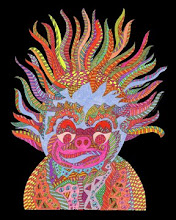Ford invites students to design a 21st Century Model T
By Jenny King / Special to The Detroit News

Jenny King / Special to The Detroit News
Ford executives chose Dong Tran's battery-powered Model T concept for best representing the spirit and purpose of Henry Ford's original Model T, which bowed 100 years ago. Tran hails from Cicero, New York, and is a junior at College for Creative Studies.
It bowed in 1908, but no one likely knows how long it took Henry Ford to develop his Model T -- one of the most important automobiles ever produced.
But 11 transportation design students at College for Creative Studies had just four months in which to grapple with their spring semester projects: vehicle concepts that could become affordable transportation and have a social impact of the magnitude of that Model T.
As part of the 100th anniversary of the Model T, Ford Motor Company challenged these young people to come up with a Model T for the 21st century.
Students, members of the CCS faculty and Ford design people gathered in the Walter Buhl Ford building on campus April 30. Each student was required to give a two-minute presentation, outlining the ideas behind the finished model and forecasting how it might be produced.
Jesse Boyer of Port Sanilac was smitten as a kid with his uncle's T-bucket: its sounds, smells and excitement. Boyer's concept had the imprint of that T-bucket on it.
Filip Bosevski created a Model T that could double as a campsite.
"My Model T features a detachable interchangeable tent frame that integrates into the body and could be used for multiple purposes - camping with friends, a roof rack or just simply as a customizable aesthetic element," he explained.
 Henry Ford loved to camp. So why not a Model T with the ability to double as a tent? Filip Bosevski, of Bitola, Macedonia, created this urban/camping vehicle, complete with boutique accessories. Henry Ford loved to camp. So why not a Model T with the ability to double as a tent? Filip Bosevski, of Bitola, Macedonia, created this urban/camping vehicle, complete with boutique accessories. |
A native of Bitola, Macedonia, Bosevski made a fashion statement not only with the vehicle but also in "matching" accessories like boots and a backpack.
Harper Woods resident David Owsen designed his green, spider-line Model T for India. He showed how the four long "legs" with tires at their ends could take the vehicle over uncertain terrain. The wheels could be drawn closer to the cabin to save space for urban driving, he said.
Following the presentations, Peter Horbury, Ford executive director, Design, The Americas, huddled briefly with colleagues, then announced that Doug Tran, of Cicero, N.Y., had best fulfilled the assignments.
Tran's battery-powered Model T will spend its summer at Ford World Headquarters. The remaining 10 projects are slated to be on display at the museum at The Henry Ford.
"We created this program because we wanted students to stretch their imagination on not only delivering a futuristic concept that had visual aesthetics, but a concept that interpreted the genius of the 100-year-old vehicle that started the automotive revolution," Horbury said.
 David Owsen of Harper Woods designed his green Ford Model T 2.0 with retractable "legs" that would allow its driver to use it on unpaved surfaces, then draw in the extensions for more compact urban transportation David Owsen of Harper Woods designed his green Ford Model T 2.0 with retractable "legs" that would allow its driver to use it on unpaved surfaces, then draw in the extensions for more compact urban transportation |
